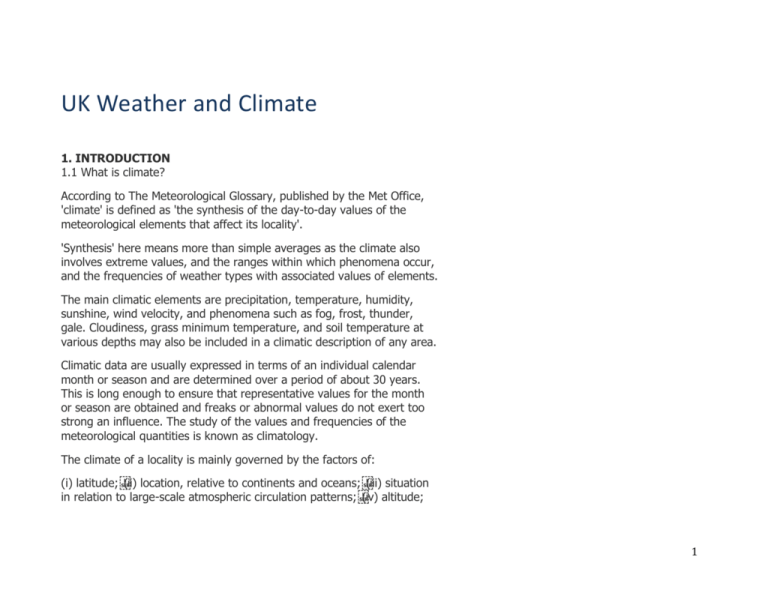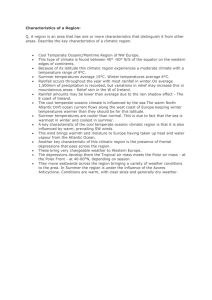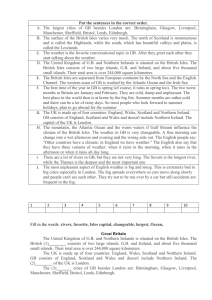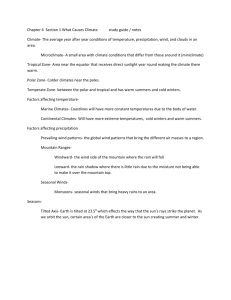UK Weather and Clima..
advertisement

UK Weather and Climate 1. INTRODUCTION 1.1 What is climate? According to The Meteorological Glossary, published by the Met Office, 'climate' is defined as 'the synthesis of the day-to-day values of the meteorological elements that affect its locality'. 'Synthesis' here means more than simple averages as the climate also involves extreme values, and the ranges within which phenomena occur, and the frequencies of weather types with associated values of elements. The main climatic elements are precipitation, temperature, humidity, sunshine, wind velocity, and phenomena such as fog, frost, thunder, gale. Cloudiness, grass minimum temperature, and soil temperature at various depths may also be included in a climatic description of any area. Climatic data are usually expressed in terms of an individual calendar month or season and are determined over a period of about 30 years. This is long enough to ensure that representative values for the month or season are obtained and freaks or abnormal values do not exert too strong an influence. The study of the values and frequencies of the meteorological quantities is known as climatology. The climate of a locality is mainly governed by the factors of: (i) latitude; (ii) location, relative to continents and oceans; (iii) situation in relation to large-scale atmospheric circulation patterns; (iv) altitude; 1 (v) local geographical features, such as topography or the nature of the built-up area. 1.2 CLIMATE OVERVIEW - THE BRITISH ISLES The British Isles have a unique climate - so much so, that a popular exam question of the past is 'Britain does not have a climate, it only has weather: discuss'. Such a statement has been made because weather conditions can vary so much from day to day, as well as from season to season. Having said this, Britain generally has cool summers and relatively mild winters. Whilst there are parts of the world with similar summers or similar winters, there is nowhere in the world with the same summers and winters as ours. The South Island of New Zealand and Tasmania, for example, have similar summers to ours, but their winters are milder chiefly because they are nearer the equator. The British Isles are small compared with the other land masses in the northern hemisphere - hence they are more influenced by the ocean compared with other European countries, and the Gulf Stream helps to keep winters milder compared with other landlocked nations with a similar latitude. The latitude of the British Isles means that they are influenced by predominantly westerly winds with depressions and their associated fronts (bands of cloud and rain), moving to the east or north-east across the North Atlantic, from the eastern coast of North America, bringing with them unsettled and windy weather, particularly in winter. Between these depressions, there are often small mobile anticyclones that bring a period of fair weather. Sometimes large, stationary 2 anticyclones become established near the British Isles where they effectively act as a 'block' to the regular passage of the depressions. These larger anticyclones can often last for over a month, and completely change the character of the weather. In winter, these blocking anticyclones bring dry weather, but with the cooling at night the drop in temperatures results in fog, which can be reluctant to clear the following day when the weak sunshine is unable to raise the temperature. If one of these anticyclones becomes positioned to north of the British Isles, often they become established over Scandinavia, and easterly winds on their southern side draw very cold air from the continent of Europe. During the summer, these blocking anticyclones can lead to drought conditions, as rain-bearing fronts are 'diverted' around the country. Such a situation occurred in 1976 when a high-pressure cell sat over the UK for much of the summer, causing a noticeable drop in precipitation, well below the normal average. There are many regional variations and microclimates in the British Isles, ranging from the nearly subtropical climate of Cornwall, to the dry semiarid conditions of East Anglia to the Arctic tundra conditions which can be experienced in the highlands of Scotland. The western and northern parts of the British Isles tend to lie close to the normal path of the Atlantic depressions, giving mild and stormy winters and cool and windy summers when the depressions track a little further north. These areas also have the highest land, and the upland barriers have the effect of producing significant increases in rainfall. The lowland, mainly on the eastern side, has a similar climate, but less severe winters. There are also other regional variations – the south is warmer than the 3 north, while the west is wetter than the east. In general, the more extreme weather tends to occur in the mountainous and hilly areas where it is often cloudy, wet and windy. It is possible to analyze the climate of the British Isles in more detail by considering the main factors governing the climate of a locality, as listed in 1.1. 1.3 LATITUDE The British Isles have a latitude between 50° N and 60° N. At this latitude, the length of daylight has a significant variation between summer and winter. For example in mid-December the period between sunrise and sunset in London is 7 hours and 50 minutes, while in Lerwick, Shetland, it is 5 hours and 50 minutes; in mid June it is 16 hours and 40 minutes in London and 18 hours 50 minutes in Lerwick. Latitude not only affects the amount of solar radiation that reaches the British Isles by hours of daylight but also the area over which a given amount of solar radiation is acting. This variation in solar radiation and length of day gives the British Isles distinct seasons. Given this mid-latitude position, the British Isles are influenced by predominantly westerly winds, and low-pressure systems with their weather fronts (bands of cloud and rain) move generally east or northeast across the North Atlantic from North America. The conditions these low pressure systems bring are generally unsettled with periods of wet and windy weather. As the British Isles lie to the west of mainland Europe, they are often the first landfall reached by the moisture-laden depressions. Thus the majority of the rain falls over the British Isles, and the fronts are usually considerably weaker by the time they reach the 4 mainland of continental Europe. The sequence of low-pressure systems is often punctuated by ridges of high pressure. These can bring periods of fine weather, and the net result is that the weather is noticeably changeable. 1.4 POSITION RELATIVE TO CONTINENTS AND OCEANS Another important factor influencing the weather of the British Isles is their position close to the ocean, rather than being in the centre of a large land mass. This is clear when comparing the climate of London and Moscow. The latter has a similar latitude to London, but London has cooler summers and milder winters. This is because Moscow is situated away from the warming effects of the Gulf Stream and other warm ocean currents that could keep the winter temperatures mild. There is a reversal during the summer, when these ocean currents help to keep London's temperatures lower than Moscow's. This is because water has a higher specific heat than land, and in the summer, Moscow is warmer, chiefly because of its location within an extensive continental land mass. Another factor is the influence of airstreams. Those reaching the British Isles originate in very warm or cold regions. However, by the time they reach us they have often had their temperature greatly modified. If the wind is predominantly westerly the air is modified by the ocean (warm Gulf Stream) and the fronts are brought in from the Atlantic. This modification by the ocean means that we experience cool summer weather or mild winter weather. 1.5 POSITION RELATIVE TO LARGE-SCALE ATMOSPHERIC CIRCULATION PATTERNS 5 A third influence affecting the climate of the British Isles is the location relative to the large-scale atmospheric circulation systems that are part of the tri-cellular model. The western and northern parts of the British Isles tend to be close to the normal path of Atlantic low-pressure systems or depressions. As a result, these areas tend to be mild and stormy in winter, and in the summer, when depressions take a more northerly route and are less deep, cool and windy. The boundary of these large-scale pressure systems varies over time, allowing a blocking anticyclone to become established. They can draw air from the continent rather than the Atlantic, giving us summer heatwave conditions or very cold winter conditions. 1.6 ALTITUDE Many meteorological factors vary with increasing (or decreasing) altitude. In general, wind speed increases with height, with the strongest winds being experienced over the summits of hills and mountains. In contrast, temperatures decrease with altitude, with the average (environmental lapse rate) change being 0.65 °C per 100 metres. However, the rate of cooling varies depending on the moisture (water vapour) content of the air. Moist air rises and cools at the saturated adiabatic lapse rate of 0.5 °C per 100 metres, whilst dry air rises and cools at the dry adiabatic lapse rate of 0.98 °C per 100 metres. Precipitation can increase with altitude as a result of relief, or orographic, rainfall. The upland barriers force up the air masses, causing them to cool, so that water vapour condenses, allowing raindrops to form and fall near the summit, or on the windward slopes. This explains why upland 6 areas such as the Lake District, have average annual rainfall totals exceeding 2,000 mm. Sometimes, the air temperature cools so much that snow is produced. It is comparatively rare near sea level in England, but much more frequent over hills, thus the average number of days when snow falls in England varies from 10 or less in the south-western coastal areas to over 50 in the Pennines. 1.7 LOCAL GEOGRAPHIC FEATURES Local geographic features have an effect on the local climate. These features include hills and valleys, forests and plains, lakes and rivers, as well as urban and rural locations. Hills and valleys can experience very different climates from the regional weather conditions. The temperature at night becomes lower in the valleys than on the surrounding hills. During the night and during the winter months, cold air flows down into the bottoms of the valleys because of its greater weight. Thus, in the valley areas, the generally lower temperatures increase the risk and the frequency of fog. During the day in summer, the valley gets higher daytime temperatures than the hills. The winds are stronger on the hills than in the valleys. In long valleys, the winds can only blow along the line of the valley. Places in the lee of hills or mountains get less precipitation than places on the windward side. This is known as a rain shadow. In winter months high temperatures can occur in the lee of high ground. These high temperatures (up to 16 °C on rare occasions) occur when a moist south to south-westerly airflow warms up downwind of mountains, an effect known as the föhn after its more dramatic effect in the Alps. 7 As far as forests and plains are concerned, summer temperatures are usually lower in the forest areas than over a plain whilst in the winter the opposite is generally true. This is because the forests can store large amounts of heat, whilst the plains react quicker to incoming and outgoing radiation. The surface of a forested area is rougher, reducing wind speed compared to the higher winds over a smoother plain. Trees extract large amounts of groundwater and store large amounts of water that is given off to the atmosphere. Hence, humidity increases over woods while there is strong evaporation over plains. Trees are used in a number of ways to modify the local climate. They are planted as shelter or windbreaks. As shelter breaks, they reduce the effect of the wind and raise the temperature. They are also planted to reduce wind erosion which helps the growth of crops. In some desert areas, this has been well developed near oases where a shelter belt is planted as outer protection to reduce the effect of the sandstorms and to stabilise the sand. Within this protective boundary, date palms are planted which, in turn, provide shade for other cropping trees that, in turn, shade crops beneath them. Proximity to water also has a marked affect on microclimate, in the same way that the sea affects the macroclimate of the British Isles. Locations near to lakes and major rivers generally have milder winters and cooler summers. There are also noticeable contrasts between urban and rural areas. Urban areas have minimum temperatures, which are higher than those recorded in the rural areas, whilst cities can also have higher maximum temperatures. These effects are known as the urban heat island, and are caused by firstly, the materials used in buildings storing and then 8 releasing heat, and secondly by the release of heat due to industrial and domestic energy consumption. Convectional rainfall and smogs can often occur more regularly in urban areas. 2. THE MAIN CHARACTERISTICS OF THE BRITISH CLIMATE This session aims to look at the main characteristics of the climate of the British Isles. In general terms, the climate of the British Isles can be summarised as follows. Temperature: the south is warmer than the north. Precipitation: the west and north-west, and more specifically the mountains in these areas are wetter than the lowlands of the east. Wind: the north and west is in general windier than the south and east, but it is less windy inland than on the coasts, and less windy in low-lying areas than on the tops of hills and mountains. 2.1 TEMPERATURE Air temperature varies on a daily (diurnal), seasonal and geographical basis. On a daily basis, the temperature is usually lower at night, when there is no incoming solar radiation, and the energy is being released back into space. Thus the coldest nights are those on which there is little wind, and there is a covering of snow on the ground, creating a high albedo effect. The lowest temperatures occur inland, away from the moderating influence of the relatively warmer sea. January is usually the coldest time of the year. The least-cold areas are the south-west of England and the Channel Islands whilst the coldest areas are the Grampian and Tayside regions of Scotland. The main factor in determining this distribution of winter temperature is the proximity of 9 the coast, particularly the west coast, and the warming Gulf Stream. Minimum temperature normally occurs shortly after dawn and the maximum temperature two to three hours after midday. In the urban areas, the minimum temperatures experienced tend not to be so low as those recorded in rural areas although maximum temperatures are often higher. Some sheltered and low-lying areas have a greater incidence of frosts, and more severe frosts, than the surrounding areas. These are known as frost hollows. July is normally the warmest month and the highest temperatures occur inland in central areas, furthest away from the cooling influence of the sea. The higher specific heat of seawater renders it slow to heat up, but equally reluctant to cool down. These differences affect the climate in a number of ways. Firstly, the sea can warm, by the exchange of sensible and latent heat, the air flowing over it therefore making parts of the British Isles warmer. It can, of course, happen the other way, when the sea is cooler than the land, the wind from the sea is cooler. This explains why sea-surface temperatures reach their lowest values in late February or early March. Thus, around the coasts, February may be the coldest month, although there may be little to choose between January and February. Localized heating can also take place depending on the nature of the environment. Urban areas can heat up differently to, and more quickly than, rural areas to produce their own urban heat island. It is not uncommon for the forecast minimum temperature for London to be at least 2 or 3 degrees higher than the surrounding comparatively rural locations. On a larger scale, temperature differences can occur as a result of 10 periodic fluctuations in sea-surface temperatures in the Atlantic Ocean. These are smaller in scale compared with the El Niño Southern Oscillation (ENSO) in the central Pacific. Even so, they are still important as far as temperatures in Britain are concerned. The sea-surface temperature changes in the Atlantic are known as the North Atlantic Oscillation (NAO), and they are governed by the behavior of the Azores high pressure and the sub-polar low pressure zones. The pressure gradient between the two zones helps to define the zone within which the mid-latitude westerly circulation occurs. When air pressure is unusually low over Iceland and high over the Azores - thus a very steep pressure gradient - the NAO is said to be positive. When both pressure areas are not significantly or poorly developed, that is the pressure gradient is weak, the NAO is negative. In positive mode, the westerlies are strengthened so that warm air and water are advected towards the British Isles. The mild winters of the 1980s and early 1990s in Britain were a time of significantly positive NAO. In the negative phase, the Icelandic low becomes displaced south-westwards, and a blocking situation develops around the British Isles with the polar high pressure penetrating southwards. The exceptionally cold winters of 1962/63 and 1941/42 are examples of this negative phase. The British Isles have the longest instrumental record of temperature for any region of the world, known as the Central England Temperature series which extends back to 1659. Temperatures over the British Isles have risen by about 0.7 °C since 1700 and by about 0.5 °C since the start of the 20th century. 11 2.2 PRECIPITATION Precipitation has been recorded in the British Isles for over 200 years. Through the dedication and enthusiasm of W R Symons, the mid-19th century saw the formation of the British Rainfall Organization whose main objective was to establish a countrywide network of rain gauges where daily measurements were made. This network has grown to over 7,000 gauges today, including many that are automatic. As most people in the British Isles know, precipitation can be extremely variable, both in intensity and duration. The spatial distribution of precipitation during an individual month is very uneven, just as it is on an individual day. Rainfall in Britain is associated with several distinct synoptic situations; all places may get rain from most such types, but some areas get more from some types than others. Therefore, it is not surprising that patterns of temporal variation of rainfall are complex. Precipitation over the British Isles is the result of one or more, of three basic mechanisms. 1. Cyclonic, or frontal, rain associated with the passage of low-pressure systems. Bands of rain are associated with the passage of warm and cold fronts across the UK. These rain events are caused by the uplift and cooling of moist air parcels. 2. Convectional, with local showers and thunderstorms, caused by the localized thermal heating and overheating of the ground surface. Large towering cumulonimbus clouds may be generated, producing heavy rain. 3. Orographic, or relief rain, with precipitation increasing with altitude over upland areas. The mechanism for relief rain is the uplift and cooling of moist air over upland areas. The normal rate of cooling 12 (environmental lapse rate) is 6.5 °C per 1,000 metres. Therefore, near the summit on the windward side of the hill or mountain, the air will have cooled sufficiently for thick cloud, rain and possibly snow to fall. Air will descend and warm on the leeward side, so there is little or no rain on this leeward side of the hill or mountain. This is called a rain shadow, and sometimes there are warm winds in these sheltered areas as the air, now much drier than during its ascent, descends quickly and warms up. This is called a föhn effect, and the warm winds are called föhn winds. 2.3 WIND Winds over the British Isles can be a resource and a hazard. Hundreds of wind turbines have been installed in exposed parts of the British Isles, adding extra megawatts of electricity to the National Grid, and exploiting this wind resource. However, severe storms can be a hazard, causing extensive damage to commercial and domestic property, as well as laying bare areas of woodland. The severe storm on 16 October 1987 cost the insurance industry around £1.2 billion, and 15 million trees were uprooted. On Burns' Day, 25 January 1990, another deep low pressure system swept across the country, with speeds of 107 m.p.h. recorded at Aberporth in Ceredigion and 98 m.p.h. at Herstmonceux in Sussex. The windiest parts of the British Isles are those on the north-west and south-west coasts, and in exposed upland areas. These are the locations across which mature depressions usually pass, and on 7 February 1969, Kirkwall in the Orkney Islands recorded a gust of 136 m.p.h. as an extremely deep and vigorous depression developed. 13 Coastal areas bear the brunt of gales from the Atlantic, especially during the winter when the low pressure cells are particularly active and well developed. These gales can pose extreme hazards for fishermen and sailors, and during the 'Great Storm of 1703' on 26 and 27 November, hundreds of ships in the English Channel and North Sea were destroyed, and an estimated 8,000 people were killed. There are local variations with warm and cool sea breezes, plus valley winds and föhn winds in the lee of upland areas. The sea breezes can create diurnal variations, with higher wind speeds in the afternoon, due to heating from the ground. Urban areas, especially those with tall skyscrapers and an irregular skyline, can also be windier than the surrounding suburbs and rural areas as the buildings disturb the local airflows and create turbulence. 2.4 SUNSHINE Mean daily sunshine figures reach a maximum in May or June and are at their lowest in December. The key factor, of course, is the length of day throughout the year, but wind and cloud play their part as well. 2.5 VISIBILITY Visibility means the distance at which the outlines of a building can be seen in daytime, or at night, at which ordinary house lights can be discerned. Before the First World War, the custom was to use terms such as haze, mist, or fog in referring indirectly to atmospheric visibility. Qualitative descriptions such as exceptional visibility were also used. These terms were not very precisely defined. The First World War and the years that followed saw the development of aviation that required more-precise information and this led to the development of numerical observations for visibility. In places where 14 visibility observations are made it has been the practice to maintain a list of permanent objects. Measuring equipment such as the Gold visibility meter and the transmissometer have also been developed for measuring visibility and their use has become more common, from airfields to motorways and ports, as well as stations recording meteorological data. Visibility variation also depends to some extent on the colour and illumination of an object being observed against its background, as well as the optical vision of the observer! Visibility is, broadly speaking, related to the concentrations of water droplets or solid particles. Conditions favouring a decrease or an increase of these constituents in the atmosphere will lead to an improvement or deterioration of visibility. When water droplets are present in suitable concentration and sizes, mist or droplet fog may be formed. The occurrence of fog is usually associated with radiation cooling or advection cooling, so that air temperatures fall below dew point. 3. REGIONAL CLIMATE OF THE UK This section looks at the different climates in each region of the UK. The notes below highlight the importance of local features in producing subtle variations. 3.1 ENGLAND Temperature - over England the mean annual temperature at low altitudes varies from 8.5 °C to 11 °C, with the highest values occurring around or near the coast of Cornwall. The mean annual temperature decreases by approximately 0.5 °C for each 100 metres increase in height so that for example, Great Dun Fell in Cumbria (at 857 m) has an annual mean temperature of 4 °C. Winter temperatures in the British Isles are influenced by the thermal 15 characteristics of the surrounding sea. They reach their lowest values in February or early March, so in coastal areas, February is normally the coldest month. Inland, away from the influence of the sea, the coldest period occurs a little earlier and January and February are the coldest months. Indeed, it was in an inland valley that the lowest temperature recorded in England was made - at Newport in Shropshire on 10 January 1982, -26.1°C. As a comparison, the coldest temperature ever recorded in Plymouth in Devon was -8.8 °C on 2 January 1979. July is normally the warmest month in England. Again, the extreme temperatures occur inland, away from the influence of the sea. The UK record temperature of 37.1 °C at Cheltenham on 3 August 1990, was beaten by a number of stations on 10 August 2003, with Brogdale near Faversham in Kent, reporting the highest at 38.5 °C. PRECIPITATION RAINFALL 16 Fig 1: Monthly averages (1961-90) of rainfall (mm) for a selection of stations in England. The Lake District is the wettest part of England, with annual totals exceeding 2,000 mm, comparable to the Highlands of Scotland. The Pennines and the moors of south-west England are almost as wet. Conversely, all of East Anglia and much of the Midlands, eastern and north-eastern England, as well as parts of the south-east experience less than 700 mm in a year. The typical occurrence for rain is about one day in three in England, especially in winter, rather than in summer, although in most years, 17 there are likely to be long dry spells. Near the south coast there is an appreciable summer minimum and winter maximum of rainfall, with totals in July about half those in January. The western, northern and eastern coasts are likely to see the driest month in spring and the wettest month in late autumn. It can be a different situation in inland areas, with parts of the Midlands experiencing a summer rainfall maximum. This reflects the higher frequency of thunderstorms (convectional rain) in the more central and south-eastern parts of England. For example thunder occurs on average 15 days per year in London and Birmingham, but in the west and northwest the frequency declines to around eight days per year. The maximum rainfall recorded in one day was 279 mm at Martinstown (Dorset) on 18 July 1955. SNOW 18 Fig 2: 30-year (196190) average number of days in month with snow lying at 0900 hours at selected stations. Snow is comparatively rare near sea level in England, but is much more frequent over hills. The average number of days each year when sleet or snow falls in England varies from about 10 or less in some south-western coastal areas to over 50 in the Pennines. Snow rarely lies on the ground at sea level before December or after March and the average number of days with snow lying in England varies from five or less around the coasts to over 90 in parts of the Pennines. The number of days of snowfall and snow cover varies enormously from 19 year to year. At many places in England in the last 50 years, it has ranged from none at all in a number of winters, to in excess of 30 days during the winters of 1946/47 and 1962/63. Even places near the coast experienced prolonged snow cover during these two winters, especially over higher ground, resulting in severe disruption to transport. Fortunately, such prolonged spells of winter snowfalls are comparatively rare. WIND Fig 3: Monthly average number of days (1961–90) with gales at selected stations. 20 The strongest winds in the United Kingdom are associated with the passage of deep depressions across or close to the British Isles. These are most frequent during winter, when the depressions are most active over the open ocean. The western coasts are most exposed to the stronger winds at low altitudes, with Ireland affording protection to much of England. The most exposed areas are the coasts of Devon and Cornwall where there are about 15 days of gale a year. Inland the number of days of gale decreases to fewer than five days a year. The highest gust recorded at a low-level site, was 103 knots (118 m.p.h.) at Gwennap Head, Cornwall, on 15 December 1979. SUNSHINE 21 Fig 4: 30-year (1961–90) average monthly duration of bright sunshine in hours for selected stations. On sunny days in summer, the formation of convective (cumulus) cloud takes place over land, whilst skies over the sea remain cloud-free. Therefore, the sunniest parts of England (and the whole of the British Isles) are along the south coast of England. Many places along this coast achieve annual average figures of around 1,750 hours of sunshine. The maximum duration in one month of bright sunshine is 383.9 hours at Eastbourne, East Sussex, in July 1911. The dullest parts of England are the mountainous areas with annual 22 average totals of less than 1,000 hours. The minimum duration in a month, was zero hours, recorded at Westminster, Greater London, December 1890. Visibility - many parts of England, especially those remote from industrial and urban areas, enjoy good visibility. This is particularly true of most coastal areas, the mountains and the moorlands. Over high ground in England, hill fog can be both extensive and frequent and it is a potential hazard to be borne in mind by walkers. Indeed, Great Dun Fell (857 metres) in Cumbria had an average of 233 days of fog per year between 1963 and 1976. Mid-Latitude Depressions An area of low atmospheric pressure occurring between 30° and 60°, shown on a weather map as a circular pattern of isobars with the lowest pressure at the center. This low is some 1500-3000 km in diameter and is associated with the removal of air at height and the meeting of cold and warm air masses in the lower atmosphere. At the fronts between the air masses, a horizontal wave of warm air is enclosed on either side by cold air. The approach of the warm front is indicated by high cirrus cloud. With the approach of the front, the cloud thickens 23 and lowers. Rain falls. As the warm sector passes over, skies clear and the temperature rises. The cold front is marked by heavier rain and a fall in temperature. The air behind the cold front moves more rapidly than the warm sector air and eventually pinches out the warm air, lifting it bodily from the ground to form an occlusion. Midlatitude depressions move at around 30 km per hour in summer and 50 km per hour in winter and last between four and seven days. An Explanation of Mid-Latitude Depressions (Wave Cyclones) Resource Changing air flow and weather as cold and warm fronts pass 24 Coastal Landscapes in Animation Waves Wind blowing across a smooth water surface wills experience some friction with the surface. This creates sma differences and eddies which instigate small ripples. As the wind continues to blow the ripples grow into waves. A w 50km/h for 30 hours will generate waves with a height of about 6m. Objects that float in water follow a circular m passes. Although the wave may move thousands of miles, transmitting its energy, the water particles do not move is some forward motion called mass transport, but it is very small in relation to the velocity and movement of the w Slideshow 01 - Coastal Processes file Wave motion in open water Resource How wave motions change as the wave enters shallow water Resource Wave motions and wave refration Resource 25 Constructive and destructive waves Resource Waves with different fetch in the English Channel Resource Zoom in on Oceans and Coasts file Waves provide Energy for Erosion 26 The Processes by which The Sea Erodes: Hydraulic Action Wave Quarrying Abrasion Attrition Corrosion/solution Cliffs also erode as a result of subaerial processes. Cliff recession occurs primarily as a result of the ma processes can only affect the base of a cliff creating a wave-cut notch. This increases the cliff’s gradient or under a cliff face will be affected by a range of weathering and slope processes, which weaken rock and eventually result Slideshow 02 - Influences on the rates of coastal erosion file Cliff Erosion Resource Wave-related processes of coastal erosion Resource Cliff Retreat and Wave-cut Platforms Resource 27 Geological 'controls' on cliff erosion Resource Coastal erosion and landforms (BBC Class Clips) file Short video clip of waves attacking the base of an arch Resource Coastal Erosion in action at North Cliff, Cornwall Resource Slideshow 03 - Coastal Landforms Created by Erosion file Wave Energy is used in Transportation A large number of beaches are aligned at an angle to the dominant wave fronts. This usually occurs where th relatively steep and the wavelength is short. In the swash zone, fragments are washed up the beach diagonally. As becomes the backwash . It flows, under gravity, back down the beach, taking the most direct route and dragging it. In 24 hours there may be up to 15,000 waves breaking, each dragging the beach fragments along the beach. Th sediments can be very great. The process is known as longshore drift , beach drift and littoral drift . Longshore Drift Resource 28 Longshore Drift explained in stages Resource How longshore drift leads to bay-mouth bars and spits Resource Longshore drift and wave direction Resource Spit formation, stage-by-stage Resource The coastline - longshore drift and spits (BBC Class Clip) file Shores and Coastal Processes Resource Slideshow 04 - Coastal Deposition file Sand Dunes & Salt Marshes Slideshow 05 - Sand Dune Systems file Sand movement and ripples on dunes and beaches Resource An introduction to Sand Dunes (Clip1) Resource An introduction to Sand Dunes (Clip2) Resource 29 Sand dunes at Braunton Burrows in North Devon Resource Environments & plants at Braunton Burrows sand dunes Lightbox Gallery How sand dunes migrate without a cover of vegetation Resource Slideshow 06 - Salt Marsh Systems file The value of salt marshes - a short video clip Resource Plants at Bideford Salt Marsh Lightbox Gallery Slideshow 07 - The impact of changing sea levels file 360 Degree Panoramas of Coastal Locations 360 Degree Panoramas of Coastal Landscapes. How has each landscape been formed? Resource BBC Class Clips - Secondary Geography : Coastal Regions 30









